Smart and Easy Business Ideas for Teens with Low Investment
 Teach Teens How Running a Small Business Prepare Them for the Future
Teach Teens How Running a Small Business Prepare Them for the Future
You may or may not already know that running a small business can teach valuable life management skills. But did you know that the teenage years are the perfect time to start honing entrepreneurial talents?
You don’t need to be anxious about your child’s future. There are a lot of small and easy business ideas for teens that they can handle with minimum supervision.
Children today have more opportunities than ever before. We have the technology and the Internet to thank for that.
As parents or guardians, you have the potential to shape young minds into becoming great entrepreneurs that can help improve the economy and society as a whole.
Why We Need to Develop the Entrepreneur Mindset in Teens
The world will always have a need for creative and innovative entrepreneurs. As they say, small businesses make up the economy’s backbone.
In the US alone, almost 50% of the workforce in the private sector work for small businesses. These companies also help create new jobs that help a lot of people.
Basic business skills can be essential life skills for teens as well. You could help them develop an entrepreneurial mentality by inspiring or encouraging them.
Who knows, maybe your child will be the next Bill Gates or Mark Zuckerberg.
Here are some traits they could acquire when they start running a small business.
• They will learn the value of money and how to manage finances.Most kids today do not realize what it takes to earn money. If they begin to understand how much work is involved in making money, then they would start appreciating it more.
Once they start to experience earning income they had to work hard for, they will be wiser in spending it. Money will all of a sudden become more valuable.
If your teen wants to become an entrepreneur, he or she also needs to learn the concepts and processes involved in managing a business. This includes something as basic as setting up a bank account.
One thing you can do is share whatever useful business experiences you have that can help them along the way. You may also encourage them to research and find out everything they can about the industry they are involved in. Industry learning that can evolve into smart business investments.
• They will be adept at solving problems and develop resilience.Businesses and problems go hand in hand. When teens become entrepreneurs, they will inevitably run into difficulties and setbacks.
Even successful teen entrepreneurs undoubtedly still have to deal with crises every now and then. What makes them thrive is their ability to rise above the challenge and get back on their feet.
Help your kids learn how to handle problems on their own by teaching them how to be systematic about it. Tell me that they should start with identifying the problem, then weigh each solution that they come up with.
Don’t be scared to let your experience child failure. Teens should be allowed to learn to make decisions for themselves and discover what consequences there may be.
Of course, this doesn’t mean that you have to distance yourself from them. Offer words of encouragement or advice that will guide them.
• They will develop the tenacity that will help them push ahead.Among the business skills for teens that are considered necessary, tenacity is perhaps the most important. Without it, children will simply give up once they feel they have reached a dead end.
Even when running a small business, teen entrepreneurs can encounter loads of problems that may prove to be too challenging for them. Tell your child that success doesn’t come easily, and they would need tenacity if they want to get through tough times.
Once they are adults, they will have learned how to push past difficult situations if they want to accomplish their goals.
• Their creativity and imagination will be enhanced.A business venture is born from a creative idea. After all, entrepreneurs are those who have come up with creative ways to fulfill existing demands or needs.
It is better to foster creativity as early as possible. When creative children hit their teenage years, they will find it easier to find opportunities where they could market their ideas.
These ideas can help them create inventions even from unexpected situations. They can come up with business ideas with low investment. You just need to provide enough support and encouragement.
Also, try to keep an open mind and learn to accept that when utilized properly, technology may be used as a tool to encourage creativity.
• They will develop their confidence and self-esteem.These two traits are crucial in helping teens realize their worth and capability. They are also needed to be able to be successful in any business.
If people sense how confident entrepreneurs are with their products and services, they will be more willing to spend money. After all, consumers want things that they think will give them value for their money.
Smart and Easy Business Ideas for Teens That Need Little Investment Businesses that make the most out of tech skills.When it comes to technology, teens today are already very much familiar with whatever latest trend or gadget there is out there. Why not take advantage of this?
Some business ideas for teenage entrepreneurs include starting an e-Commerce business, video blog, or becoming a tech consultant. These are business ideas with low investment and if your teen is knowledgeable enough, he or she could even create apps that companies might eventually pay millions of dollars for.
One of the most famous entrepreneurs that haven’t even reached 18 is Benjamin Kapelushnik. Better known as “Kickz,” he started his sneaker business while still in grade school.
Now that he’s in high school, Kickz estimates that he earns $1 million in annual sales. This is an excellent example of how e-Commerce can have the potential to become a high-paying business.
Offering tutorials or giving music lessons.If teens have the skill or capacity to share their knowledge and talents, then maybe they should start offering tutorial services or music lessons. They could easily do this even while still in high school.
Among the easiest online ideas teens could earn money from is offering tutorials that involve the latest computer program or application.
Build a startup born from teens’ interests and creativity.It is easy to start a business that reflects your interests and strong points. Teens can attract more patrons if people see that they are capable and know what they are doing.
Besides, it’s easier for teens to strive to make their business venture successful if they are motivated to see it succeed.
Experience the tried and tested business of babysitting or dog walking.Among the most popular and easy business ideas for teens to start are babysitting and dog walking services.
They are one of the many easy business ideas for teenage entrepreneurs to start because they require very minimal start-up costs. Teens can simply post fliers around the community, or advertise their services online. Certainly, these types of businesses can be considered smart business investments.
Become an errand runner that targets people on the go.Errands are the nemesis of busy people. They would be very much grateful if someone could take menial tasks off their hands, and free up some of their time.
Teens who have a lot of time on their hands are perfect for this business. It may be hard at first to build a good reputation, but they will eventually get there if they are willing to work for it.
Teens of Today Will Someday Become Leaders of TomorrowChildren are certainly the future of the world. Having teen entrepreneur characteristics helps develop independence and innovation—two traits that can help shape the world.
When teens become interested in running a small business, then they are well on their way of having a bright future ahead.
Source:
https://www.risepreneur.com/smart-business-ideas-with-low-investment/















